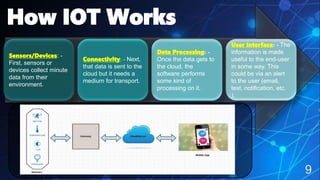IOT Presentation Seminar PPT
- 2. Contents. 2 What is internet of Things? History How IOT Works Advantages Dis-advantages Few Applications of IOT Future of IOT Conclusion References Why do we need IOT ?
- 3. What is Internet of Things? Let us look closely at our mobile phones 3
- 4. Connecting everyday things embedded with electronics, software and sensor to the internet Enabling them to collect and exchange data. What is Internet of Things? 4
- 5. The term Internet of Things is 16 years old. But the actual idea of connected devices had been around longer, at least since the 70s. Back then, the idea was often called “embedded internet” or “pervasive computing”. But the actual term “Internet of Things” was coined by Kevin Ashton in 1999 during his work at Procter & Gamble. Ashton who was working in supply chain optimization, wanted to attract senior management’s attention to a new exciting technology called RFID. Because the internet was the hottest new trend in 1999 and because it somehow made sense, he called his presentation “Internet of Things”. Even though Kevin grabbed the interest of some P&G executives, the term Internet of Things did not get widespread attention for the next 10 years. History 5
- 6. IOT continuously monitoring your health 6 Why do we need IOT ? As any irregular condition is monitored, hospital is notifiedQuickly the ambulance is sent to the patients location…..
- 7. 7 Before ambulance arrives, all the facilities are ready for the patient based on his/her reports…. Why do we need IOT ?
- 8. 8 Why do we need IOT ? to INTERACT CONTRIBUTE & TO THINGS COLLABORATE
- 9. How IOT Works 9 Sensors/Devices: - First, sensors or devices collect minute data from their environment. User Interface: - The information is made useful to the end-user in some way. This could be via an alert to the user (email, text, notification, etc. ). Data Processing: - Once the data gets to the cloud, the software performs some kind of processing on it. Connectivity: - Next, that data is sent to the cloud but it needs a medium for transport.
- 10. Advantages 10 EFFICIENT RESOURCE UTILIZATION IMPROVED SECURITY MINIMIZING HUMAN EFFORT DEVELOPMENT OF AI THROUGH IOT SAVES TIME
- 11. Dis-advantages 11 CONNECTIVITY IS MUST COMPLEXITY UNEMPLOYMENT BECOMING INDOLENT COMPATIBILITY
- 12. Few Applications of IOT 12 Smart Home In Healthcare Wearables Smart Cities Connected Cars
- 13. By 2020, it is estimated that there will be up to 21 billion connected devices More cities will become “smart”. Artificial intelligence will really become a “thing”. Routers will become more secure and “smarter”. 13 Future of IOT
- 14. Conclusion 14 One certainty is that Internet of Things change our lifestyles, It is for common good, The need is the input and support of technologists and ordinary people to make it good for individuals and the society. The info triangle can be achieved by working together. For issues of public safety and public good, there must be public discussion and public solution.
- 15. 15
- 16. References 16 https://us.norton.com/internetsecurity-iot-5-predictions-for-the-future-of- iot.html https://en.wikipedia.org/wiki/Internet_of_things https://www.google.co.in/search?q=iot+youtube+videos&rlz=1C1CHBF_enIN7 93IN793&oq=iot+youtube&aqs=chrome.0.69i59j69i60j69i57j69i60l2.3607j0j7 &sourceid=chrome&ie=UTF-8 https://iot-analytics.com/10-internet-of-things-applications/ https://www.newgenapps.com/blog/internet-of-things-apps-iot-applications- trends-2018
- 17. This is all about.. I O T Thank You.. 17
















